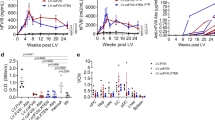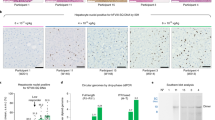Abstract
A serious impediment to gene and protein replacement therapy in hemophilia A is the development of inhibitors. Mechanisms responsible for inhibitor development include T-cell-dependent adaptive immune responses and the CD28–B7 signaling pathway that eventually leads to the formation of antibodies directed against factor VIII (FVIII). Indoleamine 2,3-dioxygenase (IDO) is a potent immunosuppressive enzyme that can inhibit T-cell responses and induce T-cell apoptosis by regulation of tryptophan metabolism. Kynurenine, one of the metabolites of tryptophan, has been implicated as an immune modulator. Here we hypothesize that co-delivery of the genes for FVIII and IDO can attenuate inhibitor formation. Using transposon-based gene delivery, we observed long-term therapeutic FVIII expression and significantly reduced inhibitor titers when the genes were co-delivered. Co-expression of FVIII and IDO in the liver was associated with increased plasma kynurenine levels, an inhibition of T-cell infiltration and increased apoptosis of T cells within the liver. These experiments suggest that modulation of tryptophan catabolism through IDO expression provides a novel strategy to reduce inhibitor development in hemophilia gene/protein therapy.
This is a preview of subscription content, access via your institution
Access options
Subscribe to this journal
Receive 12 print issues and online access
$259.00 per year
only $21.58 per issue
Buy this article
- Purchase on Springer Link
- Instant access to full article PDF
Prices may be subject to local taxes which are calculated during checkout





Similar content being viewed by others
References
Kang Y, Xie L, Tran DT, Stein CS, Hickey M, Davidson BL et al. Persistent expression of factor VIII in vivo following nonprimate lentiviral gene transfer. Blood 2005; 106: 1552–1558.
Xu L, Nichols TC, Sarkar R, McCorquodale S, Bellinger DA, Ponder KP . Absence of a desmopressin response after therapeutic expression of factor VIII in hemophilia A dogs with liver-directed neonatal gene therapy. Proc Natl Acad Sci USA 2005; 102: 6080–6085.
Liu L, Mah C, Fletcher BS . Sustained FVIII expression and phenotypic correction of hemophilia A in neonatal mice using an endothelial-targeted sleeping beauty transposon. Mol Ther 2006; 13: 1006–1015.
Long YC, Jaichandran S, Ho LP, Tien SL, Tan SY, Kon OL . FVIII gene delivery by muscle electroporation corrects murine hemophilia A. J Gene Med 2005; 7: 494–505.
Mei WH, Qian GX, Zhang XQ, Zhang P, Lu J . Sustained expression of Epstein–Barr virus episomal vector mediated factor VIII in vivo following muscle electroporation. Haemophilia 2006; 12: 271–279.
Key NS . Inhibitors in congenital coagulation disorders. Br J Haematol 2004; 127: 379–391.
Kreuz W, Becker S, Lenz E, Martinez-Saguer I, Escuriola-Ettingshausen C, Funk M et al. Factor VIII inhibitors in patients with hemophilia A: epidemiology of inhibitor development and induction of immune tolerance for factor VIII. Semin Thromb Hemost 1995; 21: 382–389.
Chao H, Mao L, Bruce AT, Walsh CE . Sustained expression of human factor VIII in mice using a parvovirus-based vector. Blood 2000; 95: 1594–1599.
Connelly S, Andrews JL, Gallo AM, Kayda DB, Qian J, Hoyer L et al. Sustained phenotypic correction of murine hemophilia A by in vivo gene therapy. Blood 1998; 91: 3273–3281.
Gallo-Penn AM, Shirley PS, Andrews JL, Tinlin S, Webster S, Cameron C et al. Systemic delivery of an adenoviral vector encoding canine factor VIII results in short-term phenotypic correction, inhibitor development, and biphasic liver toxicity in hemophilia A dogs. Blood 2001; 97: 107–113.
Herzog RW, Dobrzynski E . Immune implications of gene therapy for hemophilia. Semin Thromb Hemost 2004; 30: 215–226.
Ohlfest JR, Frandsen JL, Fritz S, Lobitz PD, Perkinson SG, Clark KJ et al. Phenotypic correction and long-term expression of factor VIII in hemophilic mice by immunotolerization and nonviral gene transfer using the Sleeping Beauty transposon system. Blood 2005; 105: 2691–2698.
Madoiwa S, Yamauchi T, Hakamata Y, Kobayashi E, Arai M, Sugo T et al. Induction of immune tolerance by neonatal intravenous injection of human factor VIII in murine hemophilia A. J Thromb Haemost 2004; 2: 754–762.
Qian J, Collins M, Sharpe AH, Hoyer LW . Prevention and treatment of factor VIII inhibitors in murine hemophilia A. Blood 2000; 95: 1324–1329.
Reipert BM, Sasgary M, Ahmad RU, Auer W, Turecek PL, Schwarz HP . Blockade of CD40/CD40 ligand interactions prevents induction of factor VIII inhibitors in hemophilic mice but does not induce lasting immune tolerance. Thromb Haemost 2001; 86: 1345–1352.
Rossi G, Sarkar J, Scandella D . Long-term induction of immune tolerance after blockade of CD40–CD40L interaction in a mouse model of hemophilia A. Blood 2001; 97: 2750–2757.
Saenko EL, Ananyeva NM, Kouiavskaia DV, Khrenov AV, Anderson JA, Shima M et al. Haemophilia A: effects of inhibitory antibodies on factor VIII functional interactions and approaches to prevent their action. Haemophilia 2002; 8: 1–11.
Ananyeva NM, Lacroix-Desmazes S, Hauser CA, Shima M, Ovanesov MV, Khrenov AV et al. Inhibitors in hemophilia A: mechanisms of inhibition, management and perspectives. Blood Coagul Fibrinolysis 2004; 15: 109–124.
Lenschow DJ, Herold KC, Rhee L, Patel B, Koons A, Qin HY et al. CD28/B7 regulation of Th1 and Th2 subsets in the development of autoimmune diabetes. Immunity 1996; 5: 285–293.
Lenschow DJ, Walunas TL, Bluestone JA . CD28/B7 system of T cell costimulation. Annu Rev Immunol 1996; 14: 233–258.
Salomon B, Bluestone JA . Complexities of CD28/B7: CTLA-4 costimulatory pathways in autoimmunity and transplantation. Annu Rev Immunol 2001; 19: 225–252.
Linsley PS, Wallace PM, Johnson J, Gibson MG, Greene JL, Ledbetter JA et al. Immunosuppression in vivo by a soluble form of the CTLA-4 T cell activation molecule. Science 1992; 257: 792–795.
Grohmann U, Fallarino F, Puccetti P . Tolerance, DCs and tryptophan: much ado about IDO. Trends Immunol 2003; 24: 242–248.
Grohmann U, Orabona C, Fallarino F, Vacca C, Calcinaro F, Falorni A et al. CTLA-4-Ig regulates tryptophan catabolism in vivo. Nat Immunol 2002; 3: 1097–1101.
Mellor AL, Munn DH . IDO expression by dendritic cells: tolerance and tryptophan catabolism. Nat Rev Immunol 2004; 4: 762–774.
von Bubnoff D, Hanau D, Wenzel J, Takikawa O, Hall B, Koch S et al. Indoleamine 2,3-dioxygenase-expressing antigen-presenting cells and peripheral T-cell tolerance: another piece to the atopic puzzle? J Allergy Clin Immunol 2003; 112: 854–860.
Miki T, Sun H, Lee Y, Tandin A, Kovscek AM, Subbotin V et al. Blockade of tryptophan catabolism prevents spontaneous tolerogenicity of liver allografts. Transplant Proc 2001; 33: 129–130.
Alexander AM, Crawford M, Bertera S, Rudert WA, Takikawa O, Robbins PD et al. Indoleamine 2,3-dioxygenase expression in transplanted NOD islets prolongs graft survival after adoptive transfer of diabetogenic splenocytes. Diabetes 2002; 51: 356–365.
Mellor AL, Keskin DB, Johnson T, Chandler P, Munn DH . Cells expressing indoleamine 2,3-dioxygenase inhibit T cell responses. J Immunol 2002; 168: 3771–3776.
Liu H, Liu L, Fletcher BS, Visner GA . Novel action of indoleamine 2,3-dioxygenase attenuating acute lung allograft injury. Am J Respir Crit Care Med 2006; 173: 566–572.
Liu L, Sanz S, Heggestad AD, Antharam V, Notterpek L, Fletcher BS . Endothelial targeting of the Sleeping Beauty transposon within lung. Mol Ther 2004; 10: 97–105.
Cao O, Armstrong E, Schlachterman A, Wang L, Okita DK, Conti-Fine B et al. Immune deviation by mucosal antigen administration suppresses gene-transfer-induced inhibitor formation to factor IX. Blood 2006; 108: 480–486.
Peng B, Ye P, Blazar BR, Freeman GJ, Rawlings DJ, Ochs HD et al. Transient blockade of the inducible costimulator pathway generates long-term tolerance to factor VIII after nonviral gene transfer into hemophilia A mice. Blood 2008; 112: 1662–1672.
Ide LM, Gangadharan B, Chiang KY, Doering CB, Spencer HT . Hematopoietic stem-cell gene therapy of hemophilia A incorporating a porcine factor VIII transgene and nonmyeloablative conditioning regimens. Blood 2007; 110: 2855–2863.
Miao CH, Ye P, Thompson AR, Rawlings DJ, Ochs HD . Immunomodulation of transgene responses following naked DNA transfer of human factor VIII into hemophilia A mice. Blood 2006; 108: 19–27.
Cao O, Dobrzynski E, Wang L, Nayak S, Mingle B, Terhorst C et al. Induction and role of regulatory CD4+CD25+ T cells in tolerance to the transgene product following hepatic in vivo gene transfer. Blood 2007; 110: 1132–1140.
Dobrzynski E, Fitzgerald JC, Cao O, Mingozzi F, Wang L, Herzog RW . Prevention of cytotoxic T lymphocyte responses to factor IX-expressing hepatocytes by gene transfer-induced regulatory T cells. Proc Natl Acad Sci USA 2006; 103: 4592–4597.
Shevach EM, McHugh RS, Piccirillo CA, Thornton AM . Control of T-cell activation by CD4+ CD25+ suppressor T cells. Immunol Rev 2001; 182: 58–67.
Shimizu J, Yamazaki S, Takahashi T, Ishida Y, Sakaguchi S . Stimulation of CD25(+)CD4(+) regulatory T cells through GITR breaks immunological self-tolerance. Nat Immunol 2002; 3: 135–142.
Stone TW, Darlington LG . Endogenous kynurenines as targets for drug discovery and development. Nat Rev Drug Discov 2002; 1: 609–620.
Fallarino F, Grohmann U, Vacca C, Bianchi R, Orabona C, Spreca A et al. T cell apoptosis by tryptophan catabolism. Cell Death Differ 2002; 9: 1069–1077.
Wells AD, Li XC, Li Y, Walsh MC, Zheng XX, Wu Z et al. Requirement for T-cell apoptosis in the induction of peripheral transplantation tolerance. Nat Med 1999; 5: 1303–1307.
Yu G, Dai H, Chen J, Duan L, Gong M, Liu L et al. Gene delivery of indoleamine 2,3-dioxygenase prolongs cardiac allograft survival by shaping the types of T-cell responses. J Gene Med 2008; 10: 754–761.
Liu Z, Dai H, Wan N, Wang T, Bertera S, Trucco M et al. Suppression of memory CD8 T cell generation and function by tryptophan catabolism. J Immunol 2007; 178: 4260–4266.
Baus J, Liu L, Heggestad AD, Sanz S, Fletcher BS . Hyperactive transposase mutants of the Sleeping Beauty transposon. Mol Ther 2005; 12: 1148–1156.
Liu H, Liu L, Fletcher BS, Visner GA . Sleeping Beauty-based gene therapy with indoleamine 2,3-dioxygenase inhibits lung allograft fibrosis. FASEB J 2006; 20: 2384–2386.
Liu F, Song Y, Liu D . Hydrodynamics-based transfection in animals by systemic administration of plasmid DNA. Gene Therapy 1999; 6: 1258–1266.
Kasper CK, Aledort L, Aronson D, Counts R, Edson JR, van Eys J et al. Proceedings: a more uniform measurement of factor VIII inhibitors. Thromb Diath Haemorrh 1975; 34: 612.
Mah C, Sarkar R, Zolotukhin I, Schleissing M, Xiao X, Kazazian HH et al. Dual vectors expressing murine factor VIII result in sustained correction of hemophilia A mice. Hum Gene Ther 2003; 14: 143–152.
Liu L, Liu H, Visner G, Fletcher BS . Sleeping Beauty-mediated eNOS gene therapy attenuates monocrotaline-induced pulmonary hypertension in rats. FASEB J 2006; 20: 2594–2596.
Acknowledgements
We gratefully acknowledge funding of this work by the Judith Graham Pool Postdoctoral Research Fellowship from the National Hemophilia Foundation to LL. We also thank Dr Zhongbo Hu for technical support in isolation of PBMC and flow cytometry.
Author information
Authors and Affiliations
Corresponding author
Rights and permissions
About this article
Cite this article
Liu, L., Liu, H., Mah, C. et al. Indoleamine 2,3-dioxygenase attenuates inhibitor development in gene-therapy-treated hemophilia A mice. Gene Ther 16, 724–733 (2009). https://doi.org/10.1038/gt.2009.13
Received:
Revised:
Accepted:
Published:
Issue Date:
DOI: https://doi.org/10.1038/gt.2009.13
Keywords
This article is cited by
-
Hyperactive PiggyBac Transposons for Sustained and Robust Liver-targeted Gene Therapy
Molecular Therapy (2014)



